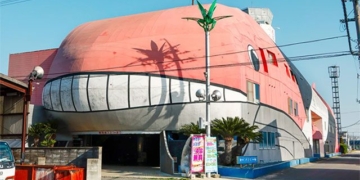Cleaning windows on high-rise buildings requires courage, a lack of fear of heights, as well as skills and experience to perform the job safely and effectively.
At dawn on a December morning, Bob Menzer takes the elevator up to the 45th floor of the Hearst Tower, a skyscraper in New York City.
He opens the rooftop door to find a clear and cold sky. Standing more than 150 meters above the ground, he hears only the sound of the wind and the hum from the giant air conditioning units. Traditionally, window cleaning in commercial buildings must always begin early in the morning to avoid disturbing tenants.
Bob, in his 50s, is a soft-spoken man with blue eyes, tousled brown hair, and a constant “worried” smile on his face. He manages the window cleaning team at the tower.
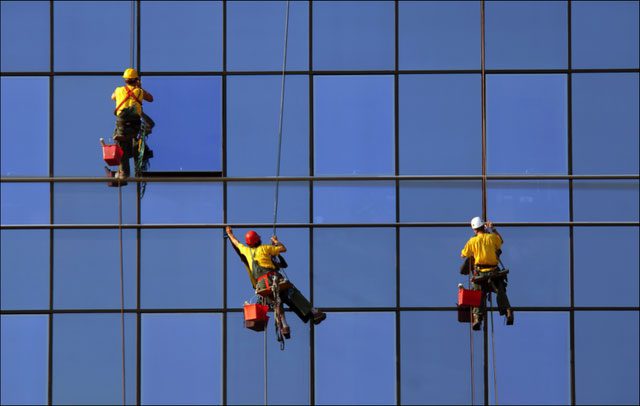
At 5 AM, he dons a dark blue safety suit, secures his harness, and puts on gloves. Alongside him are colleagues Ron Brown, 58, and Janusz Kasparek, 55, two middle-aged men preparing to descend the building to clean the most “challenging” windows in New York.
When architect Norman Foster presented sketches of the Hearst Tower before construction began, the future owner of the building posed the question: “How are we supposed to clean those windows?” The diamond-shaped window structure interwoven with each other makes it difficult for cleaners to access and clean every nook and cranny, requiring additional specialized equipment.
The window cleaning industry in New York began to thrive in the late 19th century, when a surge of skyscrapers went up everywhere. At that time, a Polish immigrant in New York immediately saw an opportunity to make money from cleaning services.
He gathered a group of window cleaning experts and hired them on contract. By 1931, when the Empire State Building was completed, there were two to three thousand window cleaners in New York. The Empire State, among the top 10 tallest buildings in New York, required only eight men to clean 6,500 windows.
According to The New Yorker, this job is nearly unskilled, and you need a bit of “connections” to join the team.
The Job Requires a “Steely Spirit”
After thoroughly checking all safety equipment, the three-person team at the Hearst Tower steps onto a movable iron platform connected to a pulley system to descend the building.
The movable iron platform, or scaffolding, is a container resembling a building railing, connected to the pulley system on the rooftop. The first iron platform in New York was built in 1952 and greatly facilitated workers in cleaning, rather than having to suspend precariously like hanging on a cliff.
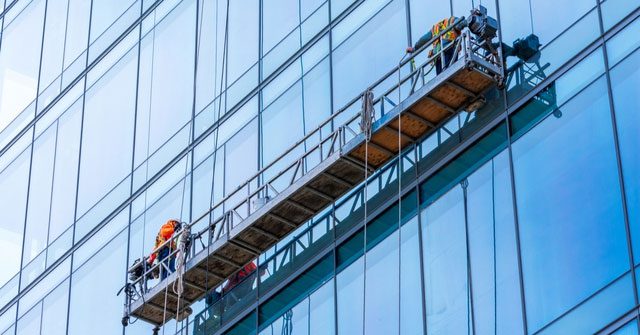
An image of a movable iron platform
However, being on the platform also requires a “steely spirit”, just like rope climbing. The higher the platform goes, the more even a slight gust of cold wind can make it sway – a terrifying feeling for anyone with a fear of heights.
Bob Menzer leans his elbows on the railing with the calmness of someone watching ducks swim in a pond. He skillfully controls the movements of the platform with a remote control. When they reach the spot needing cleaning, the team ties ropes to hanging points outside the windows to prevent them from being affected by the wind.
A typical workday takes about four hours. In favorable weather conditions, it can take a month to clean the entire tower from top to bottom. Larger skyscrapers, of course, require more time; for instance, the Time Warner Center (229 meters high) would take about four months with just six cleaners.
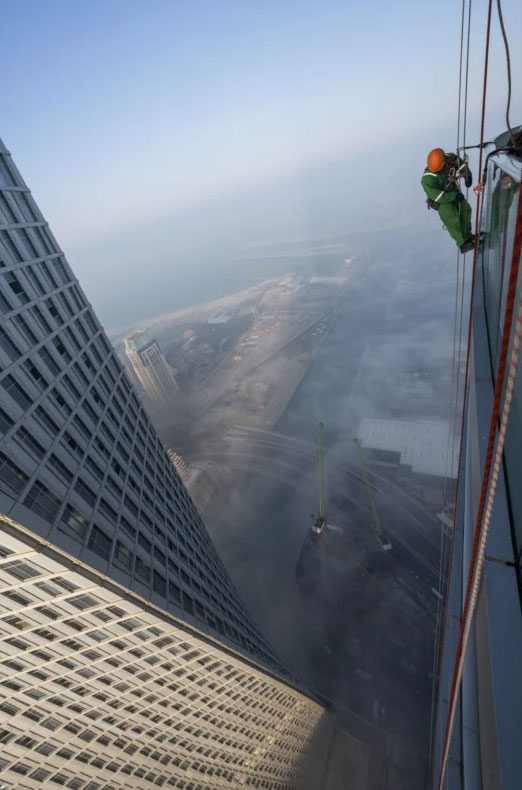
At this point, you might wonder if today’s technology has created robotic cleaners capable of replacing humans. In fact, the process of automated cleaning began in 1973, first applied at the World Trade Center, but these robots are limited in that they cannot clean in tight corners or complex bends. “Many years ago, buildings were just flat vertical panes of glass; now everything is built with more angles,” Bob Menzer notes.
Moreover, even though glass manufacturers have developed self-cleaning window coatings, or scientists in Germany and Japan have created a range of expensive cleaning devices, they seem not to have found a place in New York.
Diving deeper into the technique, cleaning inside and outside is quite similar; once the glass has been wiped with sponges, the worker will use a hand-held squeegee to wipe away the stains. Some seasoned workers are so experienced that every move looks like an art performance. They use the squeegee to glide the water smoothly and gently, making it seem as if the squeegee never leaves the glass surface at any moment.
Stains are not just simple dust, rainwater, or bird droppings; sometimes, workers have to clean up spilled coffee or strawberry jam around the windows. This is the “product” of people in surrounding buildings, who spill or “accidentally” drop liquids out of their windows. In winter, these liquids can freeze, making it impossible to clean.
Accidents Lurk Everywhere
Cleaning techniques alone are not enough to complete the job; the quality of work also depends heavily on the weather. Strong winds can hinder cleaning, and reverse gusts can push the cleaning water aside, rendering all efforts futile.
Moreover, strong air currents also affect the interior space. Zon Zeibig notes that if an office opens both the windows and doors during strong winds, papers and light objects in the room can be sucked out the window. This is also a potential danger affecting the workers.
For a long time, window cleaning in Manhattan, New York has been ranked as the most dangerous job in the world. If you are in the “window cleaning community,” you will certainly hear many stories about victims of workplace accidents, shared as a way to warn and remind each other about safety measures. It could be the story of four men who perished when a platform suddenly fell in 1962, or three window cleaners who died due to a terrorist plane crashing into the World Trade Center on September 11.
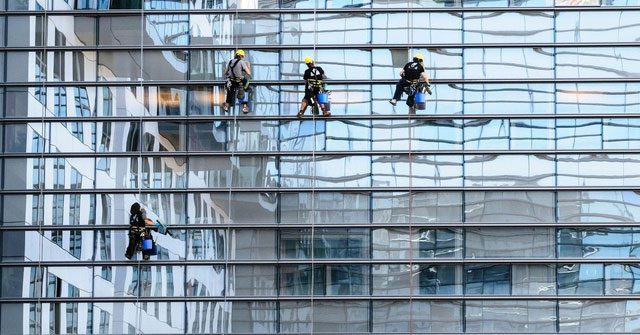
At the end of August 2008, a man named Robert Domaszowec died after falling from a building on 40 Fifth Avenue. One morning, Domaszowec climbed out, hooked his safety line, and moved along the wall. Unfortunately, the bolt came loose, and he lost his footing, falling straight from the 12th floor to the ground. Tracey, Domaszowec’s wife, painfully remarked: “Marrying a window cleaner is like marrying a firefighter or a police officer.”
Before 1932, on average, one in every two hundred window cleaners in New York died. By 1993, the government implemented many training programs, requiring all window cleaners entering the profession to spend 126 hours in class. Today, this job has a safety rate even higher than taxi driving. However, things are gradually changing; many veteran workers do not wish for their children to pursue this profession.
When asked if Bob Menzer finds this job dangerous, he calmly replied: “It’s always dangerous; accidents can happen anywhere, but you try not to think about it.”
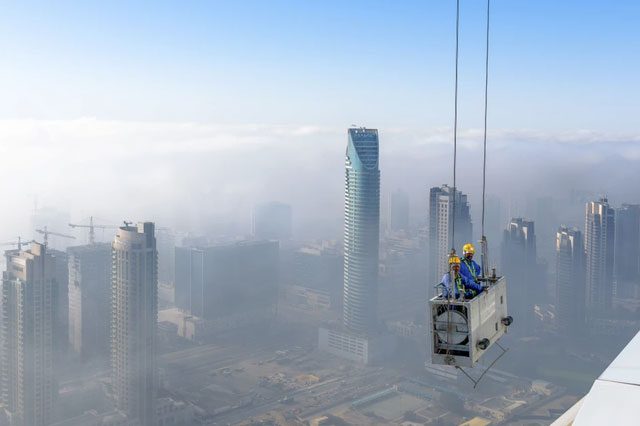
In Return, They Witness Rare Moments
If one must find a silver lining to speak about this arduous job, most people would likely describe the charming moments they have witnessed, akin to a society condensed within their view, with each building exhibiting a different personality and community.
Erik Brown, a sociology graduate, has chosen to remain in this job for many years. Reflecting on what he has witnessed, Erik cannot forget the woman working in the building across or a resident who often feeds dogs every morning.
“There were times I saw three people not focused on working but playing games,” he recalls with joy. Occasionally, tenants feel quite embarrassed when they see him appear at the window, seeming afraid of being watched and moving their computers to another spot.
Most notably, while cleaning at One Penn Plaza, a 57-story black glass building, Erik discovered a woman on the 12th floor who often held up handwritten messages at her window to say hello every time he passed by.
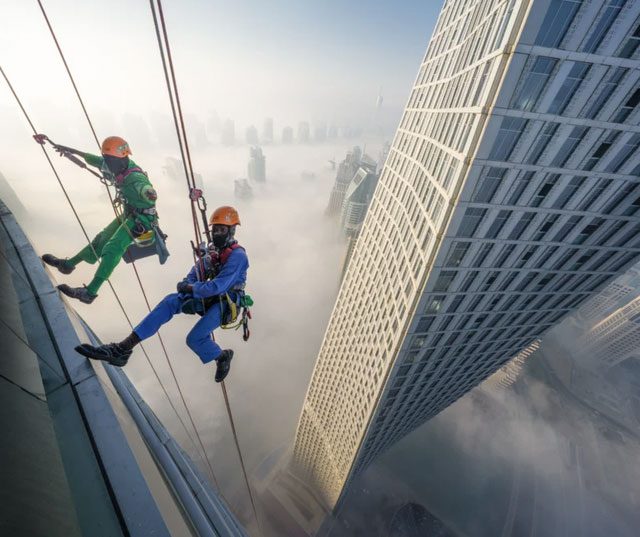
Every moment appears vividly and slowly. Each day is a new story.
The world above the fortieth floor is a realm of almost absolute silence; the isolation from the outside society is not dull but rather exhilarating. “When you come down, you hear people arguing on the street, cars, and noisy alarm sirens. But up here, you hear nothing at all, just you and your colleagues. You can talk about anything, even to yourself, and no one will scold you,” a staff member shared about their experience.



















































